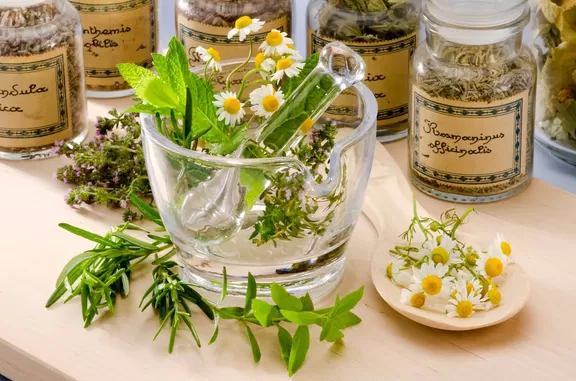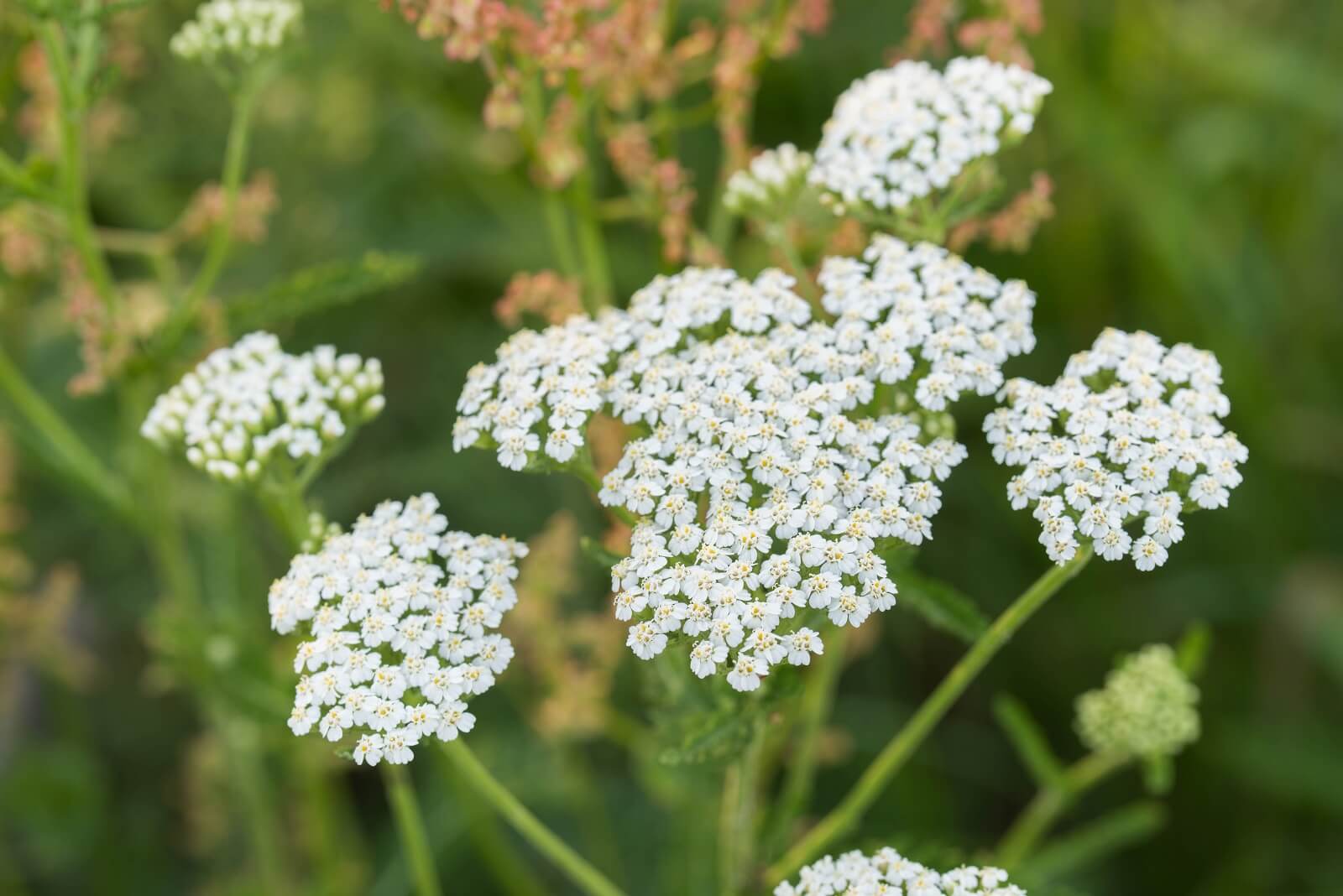
Yarrow (Achillea millefolium) is an herb that can be used to treat hemorrhoids. It has long been used to stop the flow of blood from wounds and subsequently heal them. The main reasons you’d want to look to yarrow for healing hemorrhoids (especially if you are dealing with a lot of bleeding) are:
- Helps stop bleeding
- Heals wounds
- Counters inflammation
- The essential oil is a great disinfectant
The genus of the scientific name of this herb is ’Achillea.’ This might trace its roots back to Greek mythology where the hero Achilles used the plant to treat his fellow soldiers’ wounds during the Trojan War.(source 1)
If I had a case of hemorrhoids, I would want to pair yarrow up with a powerful astringent herb like witch hazel. I would also consider taking herbs that help veins to function properly (as hemorrhoids are a form of varicose veins of the anus) such as butcher’s broom and gotu kola.
By using multiple herbs in tandem with yarrow, you probably will arrive at a more efficacious natural solution to the ubiquitous problem of hemorrhoids.
Dosage Guidelines for Yarrow
For external use, you can always make a poultice of the herb and apply it to an area in need. But for internal use, Dr. James A. Duke, a renowned expert on medicinal herbs recommended the following doses in his book The Green Pharmacy Herbal Handbook:(source 14)
- 1/2 to 1 teaspoon liquid extract or tincture 3 times a day.
- 1 to 2 teaspoons of dried herb in water 3 or 4 times a day.
- 3 teaspoons of yarrow juice daily.
Naturally Treat Hemorrhoids in 48 Hours
Jessica Wright’s unique 5-step, all-natural approach to hemorrhoid treatment delivers permanent relief. Heal hemorrhoids in 48 hours, and eliminate the root cause in 30 to 60 days.
Benefit from Jessica’s 12 years of research; her book is backed by a 60 day, 100% money back guarantee.

Yarrow Helps Stop Bleeding
A 2008 study in Current Pharmaceutical Design(source 1) states that yarrow is a popular styptic (a substance that stops bleeding) in topical medicines in the USA.
Other ethnobotanical names of this plant include: military herb, nosebleed, staunchweed, and bloodwort. This may reflect the previous use of the herb.
Additionally, the basic phytochemicals (plant chemicals) in yarrow included achillein and achilletin; which have often been reported to have the ability to stop external and internal bleeding.
According to a 2013 study in The Journal of Membrane Biology(source 2) yarrow is prescribed to treat bleeding and hemorrhoids. And it can be used as an astringent agent.
A 2011 study in DARU: Journal of Faculty of Pharmacy(source 3) also discusses yarrow’s role as something that stops bleeding. The study remarks that popular uses for yarrow are during the occurrence of bleeding and for healing wounds. Research on the phytochemicals of yarrow have shown many of them to be highly bioactive.
The study also states the possible reason yarrow has its genus name: the legend of Achilles from Greek Mythology. In addition, the study reports that Native Americans and early settlers used the herb to heal wounds, stop bleeding, and for its astringent action.
Samuel Bart’s Digestive Health Solution
Samuel Bart has always been passionate about plants and their ability to keep us healthy. He has put together some of the best natural ways that could help anyone support a healthy digestive system.
Samuel perfected an easy, yet powerful formula, which consists of amazing ingredients. Bart’s supplement is backed by a ironclad 60-day, money back guarantee.

Evidence Yarrow Heals Wounds
According to a 2012 study in Comparative Clinical Pathology(source 4) yarrow is an effective healer of burn wounds. The study reports that this herb could be considered an alternative or complementary medicine for the treatment of wounds.
To explain the study a bit more, the study used an alcoholic extract of yarrow for the treatment. In the group of rabbits receiving the herbal treatment, the wounds were washed daily with saline and then a 5 mL dose of yarrow extract was applied to the burn wound.
The study found that the rabbits receiving the yarrow treatment had much lower levels of bacteria in the wounds compared to the control group getting only saline.
Concerning wound healing, the yarrow extract exerted a powerful effect. On the 21st day of treatment, the yarrow treated wounds were sized approximately 3.27 mm; compared to the untreated group with wound sizes of approximately 98.16 mm.
How Yarrow Essential Oil Heals Wounds

A 2023 study in the Journal of Pharmacopuncture(source 5) looked at how yarrow essential oil would impact wound healing in rats. Its effects on Staphylococcus aureus (S. aureus) and Pseudomonas aeruginosa (P. aeruginosa).
S. aureus and P. aeruginosa, the study states, are the two most common pathogens found in chronic wounds. Also, bacterial infection of a wound can delay the healing process.
For treatments the study used 1%, 2%, and 3% concentrations of yarrow essential oil; additionally, Phenytoin 1% cream (a drug which may help in the healing of certain wounds; it has been used topically to heal and reduce swelling and pain) was used as a positive control (a group in an experiment that receives a proven treatment, which is certain to produce a specific effect; in this case wound healing).
The study evaluated wound closure on days 3, 6, 9, 12 after the rats were given the wounds. The study results showed that on each day of evaluation the yarrow essential oil had produced more wound closure than the positive control of Phenytoin 1% cream.
The study found that both the 1% and 2% yarrow essential oil treatment showed statistically significant improvement compared to the rats that received no treatment. The concentration of the essential oil that worked the best was the 1% concentration.
On day 9 after wounding, the 1% essential oil treatment had closed the wound by approximately 70%. On day 12 the same treatment had closed the wound by approximately 78.5%.
Below is a chart, taken from the study, that graphically depicts the experiment’s results:
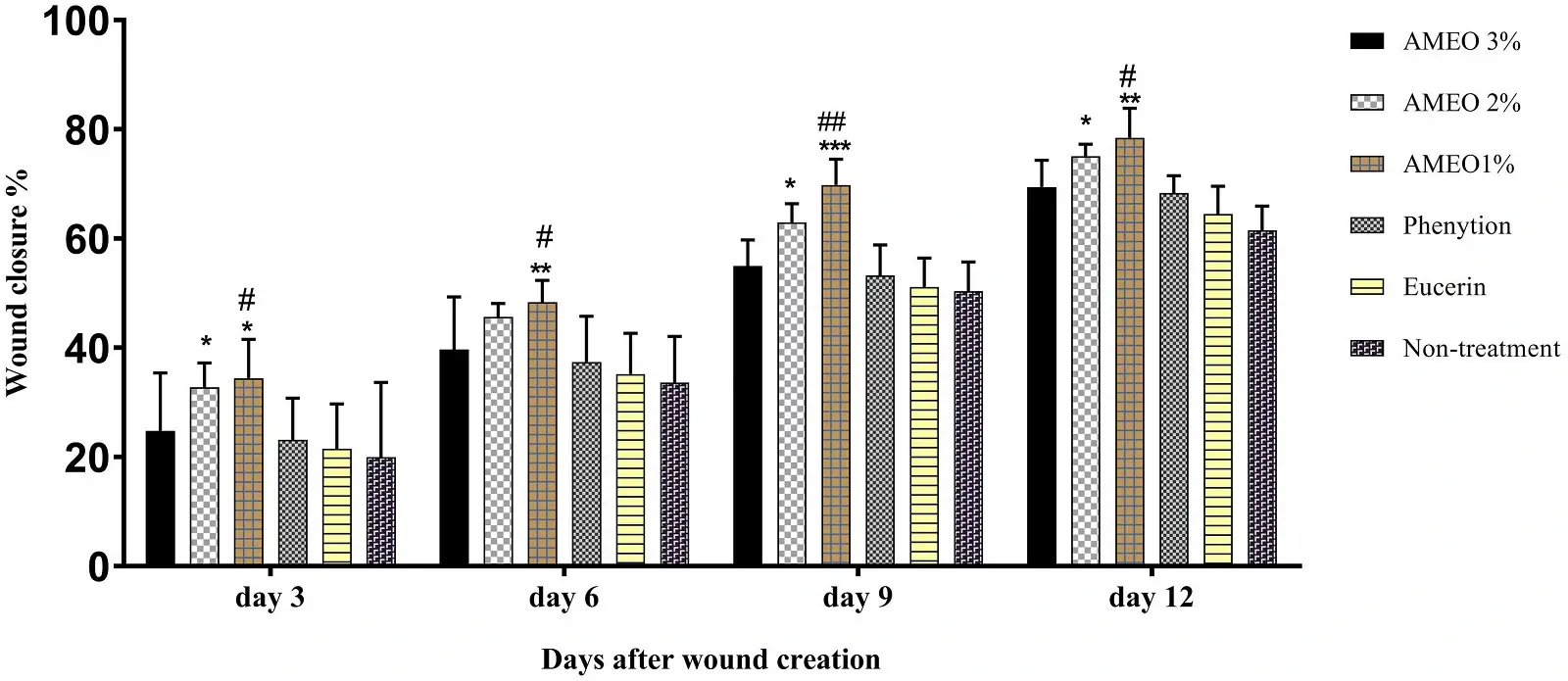
The y-axis of the chart shows the percentage of wound closure, while the x-axis indicates the days after wound on which wound closure was evaluated.
Image used under a Creative Commons license (CC BY-NC 4.0). Image source study: DOI: 10.3831/KPI.2023.26.2.167
Yarrow’s Wound Healing Ability in Episiotomy
Episiotomy is a surgically made cut at the opening of the vagina to help with women having a difficult time delivering a baby.
A 2018 study in The Journal of Maternal-Fetal & Neonatal Medicine(source 6) looked at 140 women who had given birth once and studied them to see if yarrow or St. John’s wort ointment would help in the healing of episiotomy wounds.
The study found that both yarrow and St. John’s wort reduced swelling, redness, pain, and the discoloration of the skin due to bleeding underneath. The study authors concluded that consuming either of these two herbs seemed to be useful for treating these types of wounds.
Dr. John Herzog (MD)
Dr. John Herzog, a "survival surgeon" from Maine explains what home remedies work best in a crisis situation.
This may be important in the event you require first-aid or are in an emergency situation without easy access to a hospital. Dr. John Herzog has assembled a large collection of home remedies for such scenarios.

Yarrow Helps Reduce Inflammation
A 2020 study in The American Journal of Chinese Medicine(source 7) looked at how yarrow could play a role in mice given skin lesions similar to atopic dermatitis and how yarrow would influence markers of inflammation. This study used an alcohol based extract of yarrow for their experiments on the mice.
The study found that a treatment of 1% yarrow extract reduced the overall severity of atopic dermatitis compared to mice in the control group. The study also found that transepidermal water loss was reduced by 56.7%, redness score was reduced by 64.1%, and skin thickness reduced by 67.8%.
Concerning inflammatory markers, yarrow extract downregulated the expression of pro-inflammatory cytokines (these compounds are produced mainly by macrophages [a type of white blood cell that consume foreign material and stimulate the immune response] and play a role in up-regulating inflammatory reactions).
A 2018 study in the Journal of Biological Sciences(source 8) looked at the anti-inflammatory properties of yarrow; as well as the antioxidant and anti-arthritic activities of this herb.
The study found that an ethanol (which is the alcohol in beer and liquor) based yarrow aerial parts extract exerted an anti-inflammatory effect on rat paw swelling and mouse ear swelling.
A 2017 study in the Journal of Ethnopharmacology(source 9) looked at how the topical application of yarrow oil extracts would affect skin irritation in 23 volunteers with healthy skin.
The study found that the yarrow oil extracts had an obvious anti-inflammatory ability. The skin parameters monitored by the study were restored to where they were at the start after 3 or 7 day treatments with the extracts.
Claire Goodall’s Amazing Guide
Clair Goodall is a bee-obsessed, natural medicine convert from Minnesota (USA). And, she does keep bees!
Clair has created 350+ page book documenting how to replace the toxic products and medications in your home with healthier, all-natural alternatives.

Yarrow Essential Oil, but not Extract, is a Natural Disinfectant
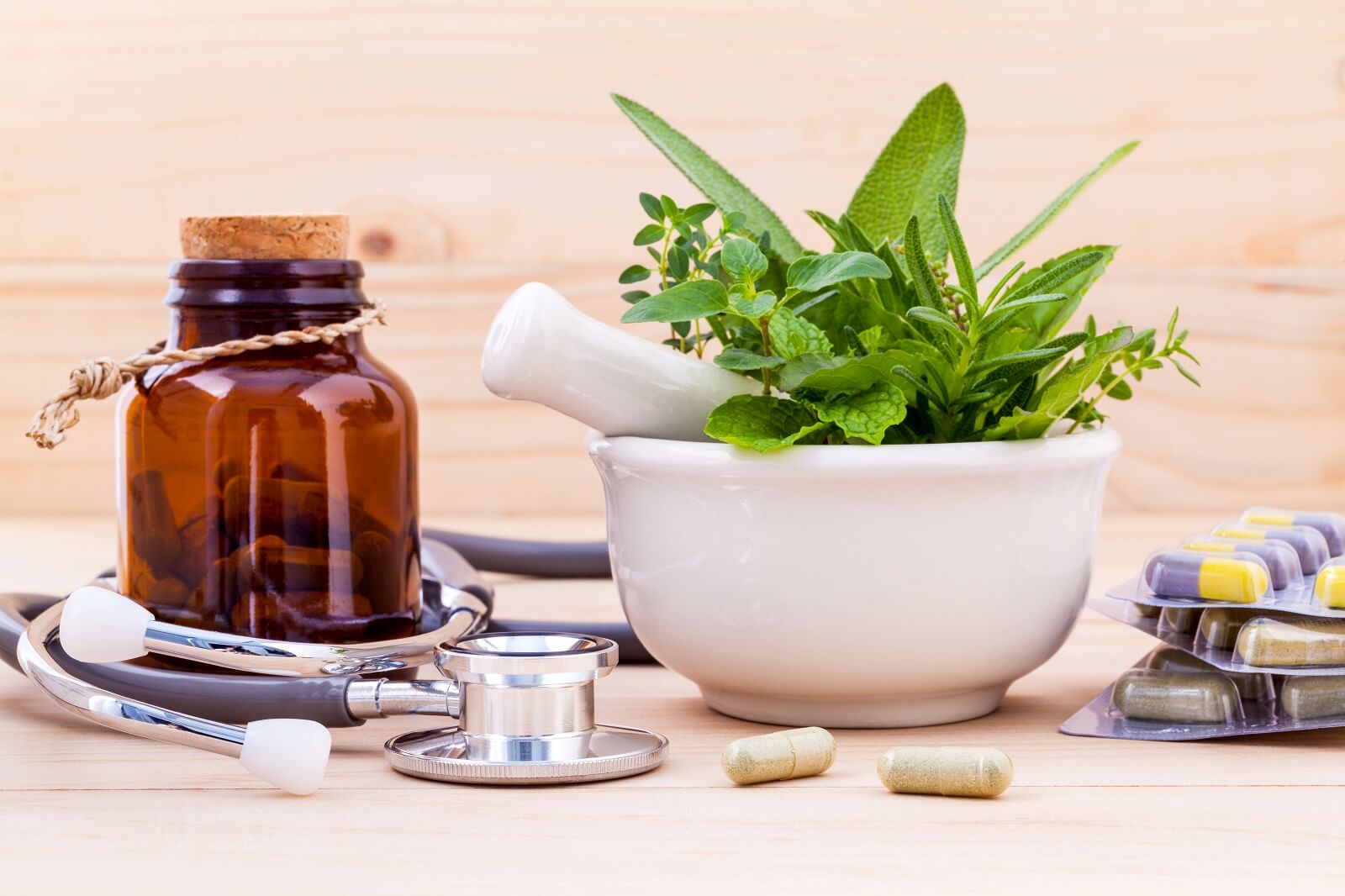
A 2013 study in Food Control(source 10) looked at how yarrow essential oil would affect Listeria monocytogenes (L. monocytogenes) and Listeria innocua (L. innocua). Specifically, the study investigated the killing power of the essential oil and how it affected bacteria protected by biofilm (biofilm is a biological sludge that certain microorganisms form that covers them and protects them from the outside environment; which can make an infection more dangerous).
Concerning Listeria, it is a pathogen that causes listeriosis infections. The U.S. CDC has this to say about Listeria infections:
Listeriosis is a serious infection usually caused by eating food contaminated with the bacterium Listeria monocytogenes. An estimated 1,600 people get listeriosis each year, and about 260 die. The infection is most likely to sicken pregnant women and their newborns, adults aged 65 or older, and people with weakened immune systems.
CDC on Listeria (Listeriosis)
The study found the minimal inhibitory concentration (MIC; i.e. the lowest concentration that halts the growth of an organism) and the minimum bactericidal concentration (MBC; i.e., the lowest concentration that kills an organism).
The following MIC and MBC values were determined:
- MIC for L. monocytogenes: 3.13% v/v (volume / volume)
- MIC for L. innocua: 3.13% v/v
- MBC for L. monocytogenes: 6.25% v/v
- MBC for L. innocua: 12.5% v/v
Concerning biofilm, the study used 2 times the MIC, the MIC, and 1/2 the MIC concentrations for their tests. The results showed yarrow essential oil stopped the initial cell attachment of the Listeria cells on polystyrene (a type of plastic; e.g., cups are made out of this plastic). Yet, the oil was less inhibitory if the biofilm had been allowed to develop for 6 hours before the oil was applied. Also, the metabolic activity of the biofilms decreased considerably after being in contact with the essential oil.
A 2011 study in Journal of Arak University of Medical Sciences(source 12) looked at how yarrow essential oil would impact Staphylococcus aureus (S. aureus), E. coli, P. aeruginosa, and Candida albicans (the most prevalent species of Candida; which is the fungi that causes most yeast infections).
The study found that the yarrow essential oil killed all of these microorganisms.
How Yarrow Extract Effects Pathogenic Microorganisms
A study published in 2000 in the Brazilian Journal of Microbiology(source 13) looked at how yarrow extract would affect several different microorganisms. The study used ethanolic extracts (1:1) of yarrow flower heads in their tests.
The following bacteria were all tested, but yarrow was found not to have any antimicrobial activity:
- Staphylococcus aureus
- Salmonella choleraesuis
- Pseudomonas aeruginosa
- Bacillus subtilis
- Candida albicans
- Proteus spp.
- Klebsiella pneumoniae
- Shigella spp.
- Enterobacter aerogenes
- Escherichia coli
Heal Hemorrhoids Naturally in 48 Hours
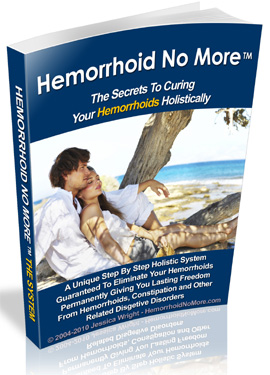
If you have tried "everything" to treat hemorrhoids, including surgery, but it didn’t work—your’re not alone. Jessica Wright experienced this same hardship due to hemorrhoids. But, with extensive research and understanding of natural medicine, she developed a solution to permanently end her hemorrhoids.
Jessica Wright wrote an entire book detailing exactly how to replicate her success. Also, it appears "Jessica Wright" is probably a pen name for a woman—and author—named Linda Allen. Linda suffered from recurrent yeast infections as well, maybe at the same time as she had hemorrhoids. She turned to natural medicine for answers when medical doctors and their solutions could not help.
Jessica’s story is one of severe and chronic hemorrhoids. It involves routine doctor’s visits, prescription medications / creams, significant suffering from hemorrhoids, and even a two hour hemorrhoids surgery (stapled hemorrhoidopexy). Yet, 12 years of these treatments didn’t resolve Jessica’s hemorrhoids.
Despite these setbacks, Jessica didn’t give up; instead, she turned to natural medicine and diligent research. Skipping to the end of Jessica’s story, she would develop a natural method to treat hemorrhoids that worked brilliantly.
After Jessica put together her treatment protocol and used it, she found her hemorrhoids completely disappeared. And, they stayed gone. Something her doctor was not able to do. Yet, all it took was the right natural therapeutic approach.
Jessica also gave her treatment approach to others; and, they experienced the same exceptional results. Typically, Jessica’s system provides dramatic relief of hemorrhoids in just 48 hours. And, the root cause of hemorrhoids is fixed within 30 to 60 days.
A company selling hemorrhoid symptom products does not want their customer base diminished. Consequently, unpatentable natural medicine does not get much attention or publicity.
So, how can you know if Jessica Wright’s claims are legitimate and not a scam? That is a great question. Here are 3 important reasons why Jessica’s book is legitimate:
- It is published by a large U.S. based company (Located in Idaho) known as ClickBank. ClickBank handles all the sales and refunds of many products like Jessica’s. They do business in many countries; and, have been in business for many years.
- ClickBank provides a 60 day, 100% money back guarantee on all their products, Jessica’s book included.
- If you are not satisfied with Jessica’s book you can simply contact ClickBank (they make it very easy) for a full refund.
Jessica’s story is more in-depth than this concise overview. And, there are additional bonuses Jessica provides with her book. If you’d like to find out more about Jessica’s personal story or her hemorrhoid treatment; you can learn more at Jessica Wright’s website.
About the Author
Nick Gross is a natural medicine enthusiast who has been researching and writing about natural medicine since 2008. Nick is primarily a web developer, but also researches and authors written and video content about natural health. Nick has a bachelor’s degree in Management Information Systems from the University of Northern Iowa.
More on Nick GrossImportant Disclosures & Disclaimers
It is important to use the information you find on Herbsey.com in the right way. Also for legal reasons, these disclaimers and disclosures are necessary. For further information about each, feel free to click the link provided to the page on this website that provides more information.
Medical Disclaimer
The information on this website is not a prescription for anyone. This information is for informational or educational purposes only, and is not a substitute for professional medical advice or consultations with healthcare professionals.
Advertisement Disclosure
Some of the links provided on this article and website are affiliate links. If you purchase a product after clicking on these links, Herbsey.com will earn a commission. Herbsey.com promotes various products through advertisement and text links. For more information: Our Advertisements.







